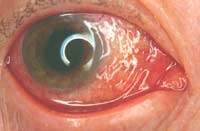Conjunctivitis
Eye Care > Diseases of the Eye > Conjunctivitis
What is Conjunctivitis?
Conjunctivitis, commonly known as pink eye, is an infection of the conjunctiva (the outer-most layer of the eye that covers the sclera).
The three most common types of conjunctivitis are: viral, allergic, and bacterial. Each requires different treatments. With the exception of the allergic type, conjunctivitis is typically contagious.
The viral type is often associated with an upper respiratory tract infection, cold, or sore throat. The allergic type occurs more frequently among those with allergic conditions.When related to allergies, the symptoms are often seasonal. Allergic conjunctivitis may also be caused by intolerance to substances such as cosmetics, perfume, or drugs.Bacterial conjunctivitis is often caused by bacteria such as staphylococcus and streptococcus. The severity of the infection depends on the type of bacteria involved.

Signs and Symptoms
Viral conjunctivitis
- Watery discharge
- Irritation
- Red eye
- Infection usually begins with one eye, but may spread easily to the other eye
Allergic conjunctivitis
- Usually affects both eyes
- Itching
- Tearing
- Swollen eyelids
Bacterial conjunctivitis
- Stringy discharge that may cause the lids to stick together, especially after sleeping
- Swelling of theconjunctiva
- Redness
- Tearing
- Irritation and/or a gritty feeling
- Usually affects only one eye, but may spread easily to the other eye
Detection and Diagnosis
Conjunctivitis is diagnosed during a routine eye exam using a slit lamp microscope. In some cases, cultures are taken to determine the type of bacteria causing the infection.
Treatment
The appropriate treatment depends on the cause of the problem.
For the allergic type, cool compresses and artificial tears sometimes relieve discomfort in mild cases. In more severe cases, non-steroidal anti-inflammatory medications and antihistamines may be prescribed. Some patients with persistent allergic conjunctivitis may also require topical steroid drops.
Bacterial conjunctivitis is usually treated with antibiotic eye drops or ointments that cover a broad range of bacteria.
Like the common cold, there is no cure for viral conjunctivitis; however, the symptoms can be relieved with cool compresses and artificial tears (found in most pharmacies). For the worst cases, topical steroid drops may be prescribed to reduce the discomfort from inflammation. Viral conjunctivitis usually resolves within 3 weeks.
To avoid spreading infection, take these simple steps:
- Disinfect surfaces such as doorknobs and counters with diluted bleach solution
- Don’t swim (some bacteria can be spread in the water)
- Avoid touching the face
- Wash hands frequently
- Don’t share towels or washcloths
- Do not reuse handkerchiefs (using a tissue is best)
- Avoid shaking hands
Illustrations by Mark Erickson
With acknowledgement to St. Lukes Eye Hospital.
